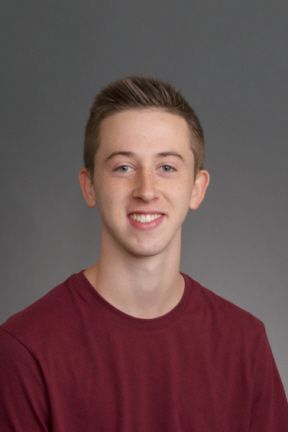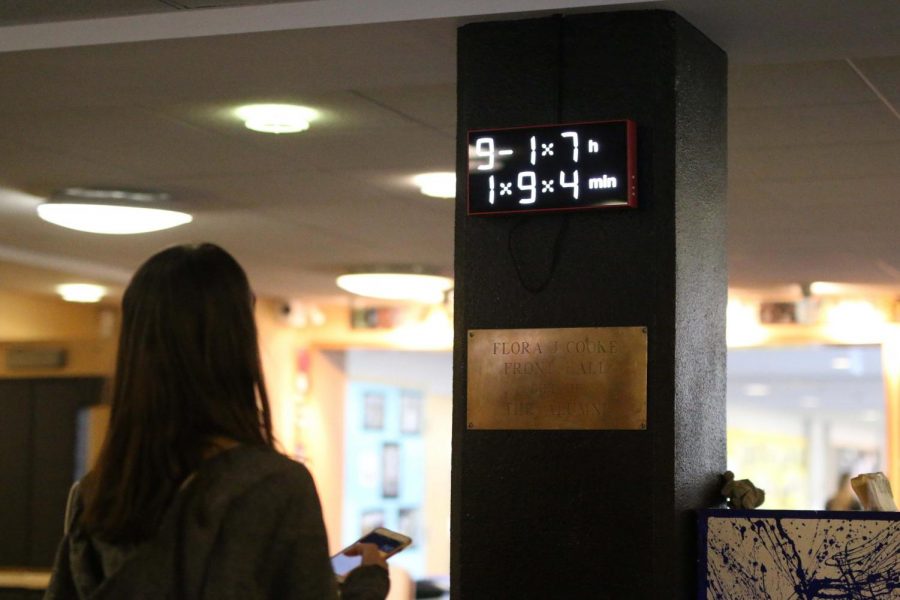Math Clocks Throughout Parker
An Innovative and Interactive Way of Telling Time
Photo credit: Jenna Mansueto
Junior Zoe Laris-Djokovic solves the math clock near the front entrance of the school.
From around 11 am to 1 pm every weekday, the six chairs in the alcove surrounding a small circular table are often occupied by students eating their lunches, or just enjoying a break. It’s a community area. And there’s an odd new clock 15 feet away from the door. And another one near the Middle School Collab Lab.
The digital clock is split into two sectors (top and bottom), the top presenting a mathematical equation of two numbers to equal whatever hour it is, and on the bottom some sort of mathematical problem to find the minutes.
For example, on a recent morning the lobby clock read, “6×2+1.”
Principal Dan Frank had the idea to bring the clocks to Parker. Frank found the clocks on the Museum of Modern Art website. “The clocks have a clean, functional design,” Frank said, “that can be set at different levels of difficulty.”
Frank originally had the Middle School clock installed then added the one in the alcove. Recently, Frank ordered two more clocks. “One will go in the Intermediate School area where the 4th and 5th grade classrooms are,” Frank said. “And another one will go in the area where most of the high school math classrooms are located near the Harris Center.”
Frank put the clocks in the school for a purpose. “The clock struck me as a fun way to celebrate and feature math around the school,” Frank said. “A clock, if presented in an interesting way, can reveal some of the math behind the operations of telling time.”
Frank thinks students and adults are enjoying them. Freshman Grayson Kamin Schementi is enjoying the clocks. “The clocks bring a sense of community to Parker,” Kamin Schementi said. “It also integrates math more into our daily lives.”
Schementi thinks the clocks might not help older kids as much, when it comes to understanding math, but he believes it can help the younger kids with their skills. He said, “It’s good to get basic math concepts into little kids’ heads.”
Freshman Nathalie San Fratello thinks the clocks are redundant and at times confusing. “How are you supposed to read a math clock?” San Fratello said. “It should have instructions in the area on how to read it.”
Middle and Upper School Director of Studies Sven Carlsson sees the clocks as opt-in. “For the people who are choosing to engage in it, it’s a little bit of fun problem solving,” Carlsson said. “An arithmetic clock sort of does something different with time, where when we see it, it’s not just telling you the time so you can then just use it for something else. You are actually interacting with the clock.”
Arithmetic is not something some students wish to do when they walk down the hallway, but Carlsson thinks the clocks should change that. “Hopefully they are causing a little bit more arithmetic to happen, and people to do a little more thinking.” Carlsson said. “Hopefully no one’s brains have been busted yet because of thinking too hard.”
Kamin Schementi agrees. He said, “It’s not like the clocks are going to harm you or anything.”
Kamin Schementi also noted that the clocks are not just for our own community–they’re for the people looking at Parker as well. “It shows how important these concepts are,” Kamin Schementi said. “It teaches us how to do quick multiplication or division in our heads, as opposed to writing it out on paper like we always do in class.”
Carlsson thinks the clocks are helping him tell time differently. “We’ve all looked at clocks for years,” he said. “I now have clocks on my phone, my wrist, and my desk, and I don’t usually look at them differently, so that’s why I think this is a cool way to look at something like time, but in a different way.”








